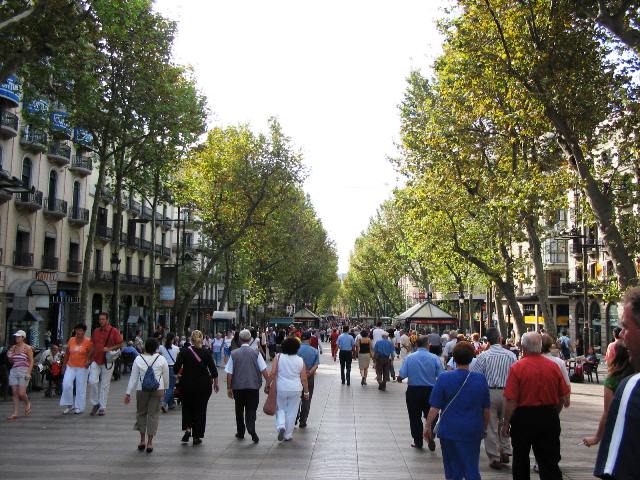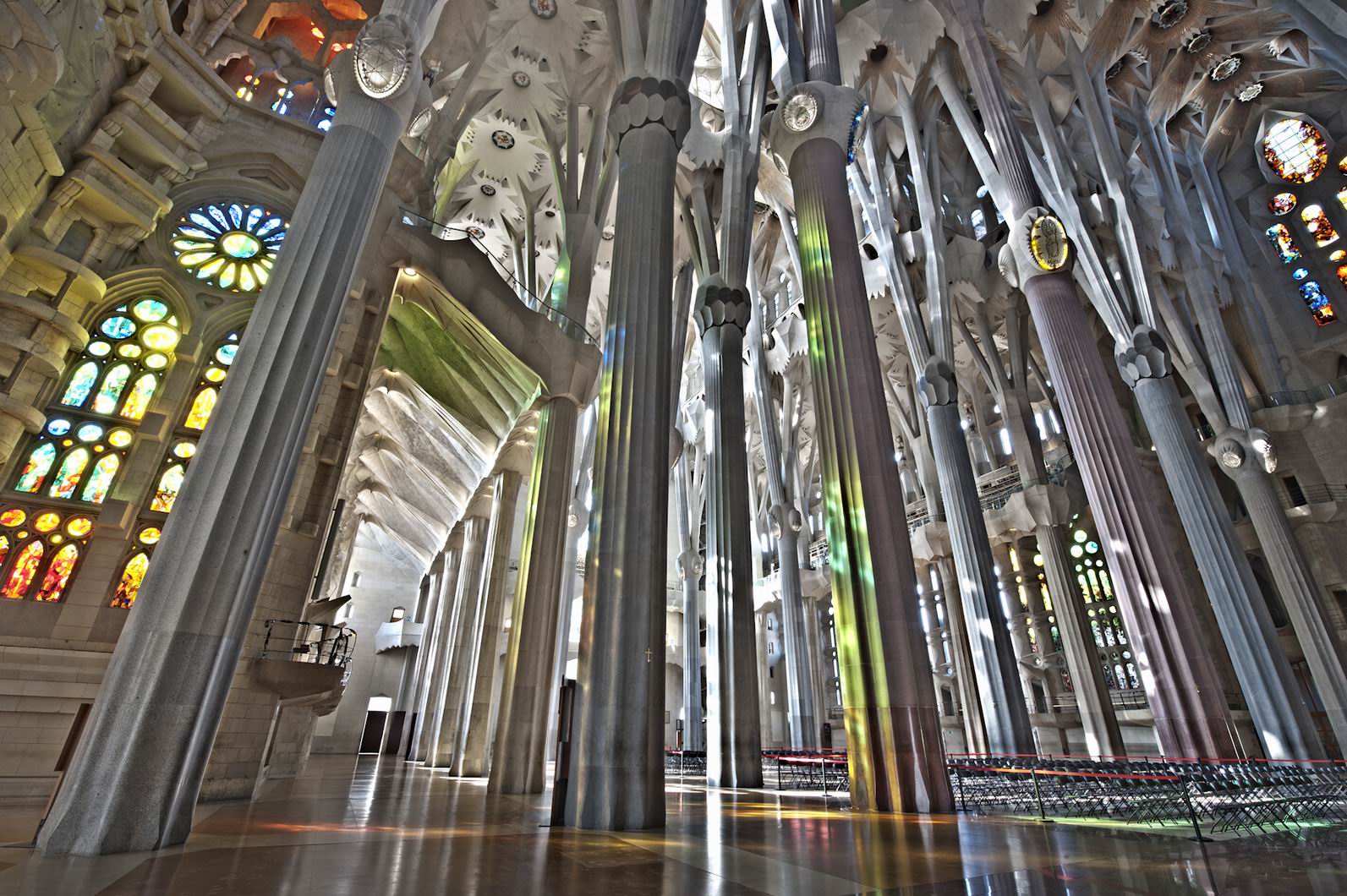Highlights of Barcelona
Plaça Reial
This is Barcelona’s central plaza, and it’s right next to La Rambla. It’s a popular meeting point as well as an outdoor concert venue. One interesting fact is that it is identical to a plaza in Mexico City! The beautiful streetlamps you see were designed by Barcelona’s favorite architect, Gaudi.
La Rambla

The Rambla is the busiest avenue in Barcelona, and is always filled with people from all over the world who are there to shop, eat, and look at the street performers and human statues. Everywhere you look there are people painted in different colors, wearing extraordinary costumes and who will move for you if you toss them a coin. The Rambla is the center of Barcelona’s pulse and the atmosphere is exciting. There are many stores and restaurants along it, and eventually it will lead you to the harbor, filled with boats and catamarans.
Modernista Dragon

You have to look up to see this Chinese dragon on the façade of what locals call the umbrella house. They call it this because there used to be an umbrella shop on the first floor. Josep Vilaseca designed this modernist building using many different themes. For example, there is Egyptian imagery, stained glass windows, oriental umbrellas and fans, and this dragon!
Mercat de Sant Josep
Commonly known as La Boqueria, this large market offers everything from candy and fresh-squeezed juice to the best ham in the region. All of Catalonia’s regional dishes are sold here for you to try, and even the best chefs in Barcelona buy their groceries here, so they can vouch for the quality of food!
Font de Canaletes
Legend says that anyone who drinks from this fountain will fall in love with Barcelona and return to the city again in the future! This ornate fountain was rebuilt in the late 1800s, exactly where a fountain dating back to the 1500s used to be. The fountain is of great importance to the Barcelona's football club fans, as they have a long tradition of gathering around the fountain to find out their team’s scores. The scores used be written on a blackboard in front of the newspaper’s office, which was here by the fountain.
Columbus Monument
This tall monument portrays Christopher Columbus pointing towards the New World with one hand, and holding a scroll in the other. It was designed as a tribute to Columbus’ return to Spain and to his first report to the King and Queen in Barcelona. It was built in time for Barcelona’s 1888 Universal Exposition and all construction was completed by Spanish workers! It might not look like it, but the inside is actually hollow, and you can take an elevator up to the top.
Barri Gòtic

Barri Gòtic means Gothic Quarters, and this is the oldest part of Barcelona. Many of the houses date from Medieval times, and at many buildings’ gardens you can see how much civilization has built itself up compared to many centuries ago. The cathedral and Jewish Quarter are also located here.
Cathedral
This cathedral, located in the heart of the Old City, can sometimes be pushed to the side when being compared to La Sagrada Familia. However, it really is a masterpiece of architecture and history, given that it’s history started in the 1200s! The only thing that remains from its original structure is the baptistry. In total, it took 6 centuries of work to finish this cathedral. It is a blend of different architectural styles, but with Gothic being the primary. There are 29 chapels inside, and a cloister dedicated to Barcelona’s patron saint, Santa Eulàlia, who was martyred when she was 13.
Palau de la Música Catalana
This concert hall is one of the most grand examples of Catalan modernism. It is covered in tiles, metallic sculptures, ceramic, and a multitude of colors that make the inside look like a rainbow. The main concert hall is looked over by a large organ, and the ceiling is a huge, multi-colored, glass skylight. It’s not just pretty though, reconstruction in 1989 gave the acoustics and comfortability an upgrade. Many famous singers, orchestras, composers, and other artists have performed here-Woody Allen included!
Quadrat d'Or
Barcelona’s wealthy families built this neighborhood that nowadays you can find walk around and find exquisite examples of modernism. Each family tried to outdo the other, and used many different materials to create the most aesthetically pleasing modernist house. It’s almost like a free, open-air museum!
Casa Milà

This house is an incredible feat of architecture! Gaudi built it on the corner of two streets, and with its undulating outside walls, it gives the sensation of waves and the sea. Even the railings blend with his style, as they closely resemble seaweed! Gaudi threw out the idea of straight lines both inside and out, and gave the inside courtyards a round floor plan, as well as covering up the chimneys with huge sculptures that look like medieval knights’ helmets. Exploring Casa Milà is not like exploring a house, it’s more like taking a peek into Gaudi’s brain and trying to figure out how he imagined all this!
Casa Batlló

Casa Batlló is said to be inspired by a dragon’s back, as its roof looks like scales and is curved like the back of a dragon. Similar to Casa Milà, it is a fantastical blend of colors, shapes, and movement, but maybe even more so! Gaudi had free reign on this house, so he created designs that symbolize the creator, the Milky Way, and the tibias (which represents calcium, the mineral that makes life possible). The banister of the main staircase looks like an animal’s hard back, and he also installed a huge skylight to allow light to enter the whole building. Everywhere you look there are colors and sculptures twisting and turning into each other, creating a surreal experience.
Park Güell

Park Güell was designed by Gaudi in 1900 and its purpose was to provide the bourgeoisie of the city with a beautiful garden. He also built two houses, one of which he lived in until he moved to the Sagrada Familia. The bourgeoisie didn’t like what he did, and his plans for a church and more houses were never finished. However, today it is a relaxing park to wander in, and has some very intriguing sights, such as a huge mosaic salamander on the side of some steps! The famous curving benches with mosaic inlays that everyone takes pictures at? Here in Park Güell! They were designed not by Gaudi, but by one of his close friends, Josep Maria Jujol. With Gaudi there is always more than meets the eye, and the giant platform up above is no exception. The park is on a hill, and in order to capture and utilize the rainwater, the platform traps and filters it down to an underground well. Brilliant! Park Güell is a fun place to explore and really see Gaudi’s modernist style in nature.
Sagrada Familia

Barcelona is partly set apart from other Spanish cities because of the work of Antoni Gaudi. His art is seemingly everywhere, and nowhere is his unique modernismo style more obvious than in the Sagrada Familia. If you see one thing in Barcelona, it must be this temple because there is nothing else like it in the world. The light enters the many stained glass windows inside and creates rainbows, and the curving, flowing architecture creates an Alice in Wonderland feeling. Construction first started in 1952, and they think it will finally be done between 2020 and 2040. It is an enormous task, and entwined with controversy over what Gaudi’s original plans actually were, since anarchists burned some of them. No matter that, construction continues. Did you know that Gaudi actually lived here and is buried inside? Surrounded by his plans and papers, some compared him to a monk doing God’s Work.
There are three different facades on the outside of the temple- the Passion Façade, the Glory Façade, and the Nativity Façade, each crowned with four towers. In total, there will be 12 towers to represent the 12 disciples. Inside the Sagrada Familia are many pillars of different colors, stained glass windows, and an altarpiece covered by a canopy decorated with vines and grapes. There is so much to see that it is possible to spend hours here.
Parc de la Ciutadella
The Citadel Park is now home to a zoo, lake, waterfall, museum of natural science, and a few of the buildings that remain from the destruction of the original Citadel. In the 1700s King Phillip V constructed what was at the time the largest fortress in Europe after Barcelona’s defiance during the War of the Spanish Succession. This fortress was despised by Barcelona’s citizens, who had to build it, pay for it, and live by this reminder of the Spanish central government. Finally, in 1869 most of the buildings were destroyed, and a park was built in its place. For a long time it was the greenest place in Barcelona.
Port Vell Marina
This harbor was built as part of the city’s attempts at modernization and urban renewal before the 1992 Barcelona Olympics. Today many boats dock here and there is a large indoor mall, movie theater, and best of all, Europe’s largest aquarium!
Born Neighborhood
This neighborhood is similar to the Gothic Quarter, but as it’s situated a little farther away from the center of the city, it tends to be a little more calm. It’s a hip neighborhood, with lots of young people, artists, and a vibrant night life. The center plaza used to be used for jousting, but today is the place to hang out. There are many boutiques, upcycled stores, cafés, and other treasures to be found walking around the Born Neighborhood.
Museo Picasso
Did you know Picasso moved to Barcelona with his family when he was 14? As such, there is a museum here honoring his genius. They have 3,500 pieces from all periods of his career, spread out among five medieval stone mansions.
Basílica de Santa María del Mar
This church, located in the Born Neighborhood, is a harmonious union of simplicity and gothic architecture. It only took 54 years to complete-which was pretty short for back then! It is more empty and not as decorated as other churches tend to be, but that doesn’t mean it’s not beautiful! Anarchists set it on fire in 1936 and much of its baroque decorations were destroyed. After its destruction they decided to restore it in a way that would maintain its somber and elegant style.
Port Olímpic
This is the other seaside port in Barcelona, built for the 1992 Olympic Games. It is right by the Olympic Village, and surrounded by high class restaurants, bars, hotels, and modern art sculptures.